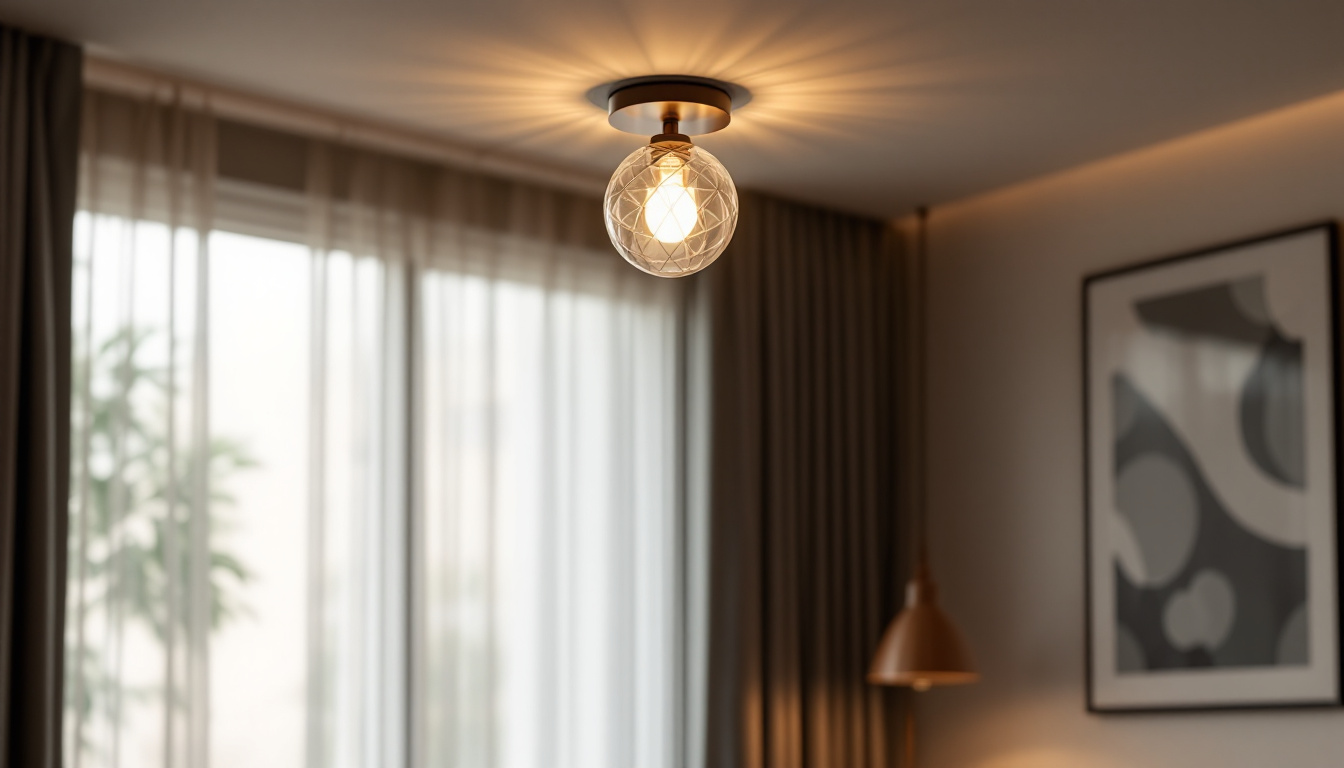

Flushmount light fixtures are a staple in modern lighting design, offering both functionality and aesthetic appeal. For lighting contractors, understanding the best practices surrounding these fixtures is crucial for delivering quality installations that meet client expectations. This article delves into the essential aspects of flushmount light fixtures, from selection to installation, ensuring that contractors can confidently navigate the nuances of this popular lighting option.
Flushmount lights are designed to be mounted directly against the ceiling, providing a sleek and unobtrusive look. They are often used in spaces with low ceilings, where hanging fixtures might pose a challenge. Their versatility allows them to be utilized in various settings, including residential, commercial, and industrial environments. The unobtrusive nature of flushmount fixtures makes them an excellent choice for creating a clean and modern aesthetic, while also ensuring that they do not interfere with the overall design of a room.
There are several types of flushmount fixtures available, each catering to different design preferences and functional needs. Some of the most common types include:
Flushmount fixtures can be used in a variety of applications, making them a versatile choice for contractors. They are ideal for:
In addition to these applications, flushmount fixtures can also be found in kitchens and dining areas, where they provide essential task lighting for food preparation and dining experiences. Their ability to blend seamlessly with various decor styles makes them a popular choice for homeowners looking to achieve a cohesive look throughout their living spaces. Furthermore, flushmounts can be equipped with smart technology, allowing users to control lighting remotely or set schedules, adding an extra layer of convenience to modern living.
Selecting the appropriate flushmount fixture requires careful consideration of several factors. Lighting contractors should assess the specific needs of each project to ensure optimal results.
Understanding the dimensions and purpose of the space is paramount. For instance, larger rooms may benefit from multiple fixtures or larger designs, while smaller areas might require compact options. Additionally, the ceiling height and style can influence the choice of fixture. A room with a low ceiling may necessitate a sleek, low-profile design to avoid overwhelming the space, whereas a room with higher ceilings could accommodate more elaborate fixtures that draw the eye upward, creating a sense of grandeur.
Moreover, the overall decor and style of the room should be taken into account. A modern, minimalist space might call for a sleek, geometric flushmount, while a more traditional setting could be enhanced by a fixture with ornate detailing. The materials used in the fixture, such as metal, glass, or even wood, can also complement the existing design elements, creating a cohesive look that ties the room together.
Another critical aspect is the light output, measured in lumens. Contractors should evaluate the desired brightness based on the room’s function. For example, kitchens and workspaces often require brighter lighting, while living areas might benefit from softer illumination. It’s essential to strike a balance; too much brightness can create discomfort, while too little can hinder functionality. Dimming options can also be considered, allowing for flexibility in light levels depending on the time of day or activity.
Color temperature, measured in Kelvin, also plays a significant role in the ambiance of a space. Warmer tones (2700K-3000K) create a cozy atmosphere, while cooler tones (4000K-5000K) can enhance focus and productivity. Additionally, the choice of color temperature can influence the perception of colors within the room. For instance, warmer lights can make wood tones and warm colors appear richer, while cooler lights can make spaces feel more open and airy. Understanding the psychological effects of color temperature can help contractors make informed decisions that align with the intended mood of the space.
Proper installation is essential for the performance and longevity of flushmount fixtures. Following best practices can help ensure a smooth installation process and satisfactory results.
Before beginning any installation, contractors should prioritize safety. This includes turning off the power to the circuit and using appropriate personal protective equipment. Additionally, reviewing the manufacturer’s instructions can provide valuable insights into specific installation requirements.
Flushmount fixtures typically come with a mounting bracket that should be securely attached to the ceiling. It is crucial to ensure that the bracket is level and properly anchored, especially in drywall or plaster ceilings. For heavier fixtures, additional support may be necessary to prevent sagging or detachment over time.
Wiring is a critical component of flushmount fixture installation. Proper techniques not only ensure functionality but also enhance safety.
Contractors should be well-versed in local electrical codes and regulations, which dictate how fixtures should be wired and installed. Adhering to these codes is essential for compliance and safety.
Using the appropriate gauge of wire is vital for safe operation. For most residential applications, 14-gauge wire is standard, but larger fixtures or longer runs may require 12-gauge wire. Contractors should also ensure that connections are secure and insulated to prevent electrical hazards.
Even the best-installed flushmount fixtures may require maintenance over time. Understanding common issues and their solutions can help contractors provide excellent service to their clients.
Dust and grime can accumulate on flushmount fixtures, affecting their performance and appearance. Regular cleaning with a soft cloth and mild detergent can help maintain their shine and functionality. Contractors should advise clients on the best cleaning practices to keep fixtures looking new.
Occasionally, flushmount fixtures may flicker, dim, or fail to operate altogether. Common causes include faulty bulbs, loose connections, or issues with the electrical circuit. Contractors should be prepared to diagnose these problems and recommend appropriate solutions, whether it involves replacing a bulb or tightening connections.
As energy efficiency becomes increasingly important, contractors should consider the sustainability of the flushmount fixtures they recommend and install.
LED flushmount fixtures are an excellent choice for energy-conscious clients. They consume significantly less energy than traditional incandescent or fluorescent lights and have a longer lifespan, reducing the need for frequent replacements. By promoting LED options, contractors can help clients save on energy costs and lower their carbon footprint.
Incorporating smart technology into flushmount fixtures can also enhance energy efficiency. Smart bulbs and fixtures allow for remote control, scheduling, and even integration with home automation systems. This not only provides convenience but also enables clients to optimize their energy usage.
Staying updated on design trends can help contractors recommend fixtures that align with current aesthetics and client preferences.
Minimalism continues to dominate interior design, with flushmount fixtures often featuring clean lines and simple forms. These designs blend seamlessly with various decor styles, making them a popular choice for modern homes.
Conversely, vintage and industrial-inspired flushmount fixtures are gaining popularity. These designs often incorporate materials like metal and glass, offering a unique character that appeals to clients looking for distinctive lighting solutions.
Effective communication with clients is essential for successful lighting projects. Educating clients about flushmount fixtures can enhance their understanding and satisfaction with the final outcome.
Contractors should take the time to explain the various flushmount options available, including differences in styles, materials, and light sources. This empowers clients to make informed decisions that align with their preferences and needs.
Setting clear expectations regarding installation timelines, costs, and maintenance can help build trust and ensure a positive client experience. Open communication fosters a collaborative relationship, leading to successful project outcomes.
Flushmount light fixtures offer a versatile and stylish lighting solution for a variety of spaces. By understanding the best practices surrounding their selection, installation, and maintenance, lighting contractors can enhance their service offerings and meet client expectations. Staying informed about trends and energy-efficient options further positions contractors as knowledgeable professionals in the field. Ultimately, a commitment to quality and client satisfaction will ensure continued success in the ever-evolving world of lighting design.
Ready to elevate your lighting installations with the finest flushmount fixtures on the market? Look no further than LumenWholesale, where we provide lighting contractors with exceptional, spec-grade lighting products at unbeatable wholesale prices. Our commitment to quality and affordability ensures that you can access a wide range of reliable, high-performance lighting options for every project. Plus, with free shipping on bulk orders, you can stock up on premium lighting solutions without worrying about hidden fees or compromises. Don’t miss out on the perfect blend of quality, affordability, and convenience. Discover the best value in wholesale lighting by visiting LumenWholesale today.

Discover how pendant lighting can transform your space and boost the efficiency of your lighting projects.

Discover essential insights for lighting contractors on electrical outlets, including installation tips, safety guidelines, and the latest industry standards.

Discover the ultimate guide to choosing the best outdoor motion detector light for your home.

Discover essential tips and best practices for lighting contractors working with linear LED lights.
Get notified when NEW deals are released.
Optimize your budget with wholesale discounts.
Only top-quality, specification-grade lighting products.
No additional costs at checkout - what you see is what you pay.
We understand the unique needs of contractors.